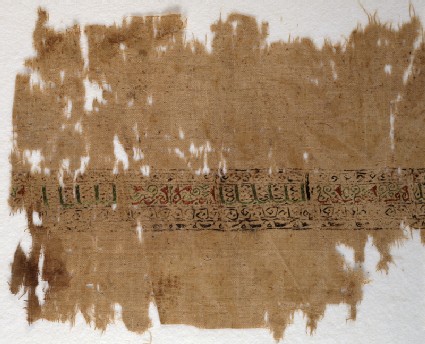Browse: 10610 objects
- Reference URL
Actions
Textile fragment with band of pseudo-inscription, leaves, and vines
-
Details
- Associated place
-
Near East (place of creation)
- Date
-
12th century (1101 - 1200)
Fatimid Period (AD 909 - 1171)
- Material and technique
- linen, embroidered with red, green, and black silk
- Dimensions
-
33 x 19.5 cm max. (length x width)
along length/width 15 / 17 threads/cm (thread count)
ground fabric 0.06 cm max. (thread diameter)
ground fabric 0.04 cm min. (thread diameter)
additional fibre, embroidery 0.05 cm (thread diameter)
- Material index
-
organic › animal › animal product › silk
- Technique index
-
woven › plain woven,assembled › woven › plain woven,
- Object type index
- No. of items
- 1
- Credit line
- Presented by Professor Percy Newberry, 1941.
- Accession no.
- EA1984.523
-
Further reading
Ellis, Marianne, Embroideries and Samplers from Islamic Egypt (Oxford: Ashmolean Museum, in association with Greenville: Curious Works Press, 2001), no. 7 on p. 19, p. 8, illus. p. 19
Barnes, Ruth and Marianne Ellis, ‘The Newberry Collection of Islamic Embroideries’, 4 vols, 2001, Oxford, Ashmolean Museum, cat. vol. iii, illus. vol. i
Location
-
- currently in research collection
Objects are sometimes moved to a different location. Our object location data is usually updated on a monthly basis. Contact the Jameel Study Centre if you are planning to visit the museum to see a particular object on display, or would like to arrange an appointment to see an object in our reserve collections.
Publications online
-

Embroideries and Samplers from Islamic Egypt
The detail shown here is taken from part of a band that is very similar to No.6 [EA1984.110] in style and materials, as well as in the way the elements of the design relate to kufic letters. Short inscriptions repeating generalised phrases such as "Victory comes from God" and "What God wiIls" are common on fine quality garments and scarves in the 12th century. Here embroidery follows the trend but the simulated writing is illegible. The stilted appearance of the scrolls also suggests that tapestry-woven textiles served as models; curves distorted by the constraints imposed by tapestry weaving have been copied by the embroiderers who had no such limitations. The fragment was probably part of a cloth that served as a towel or cover. -

The Newberry Collection of Islamic Embroideries
A band containing an inscription embroidered green and red, with leaf and vine ornaments as background filler, as well as interlacing in black embroidery. The inscription has a border with black spiral design, as well as leaves or birds along the lower border. Technique and design are similar to EA1984.110.
The textile probably was a pseudo-tiraz.
© 2013 University of Oxford - Ashmolean Museum


